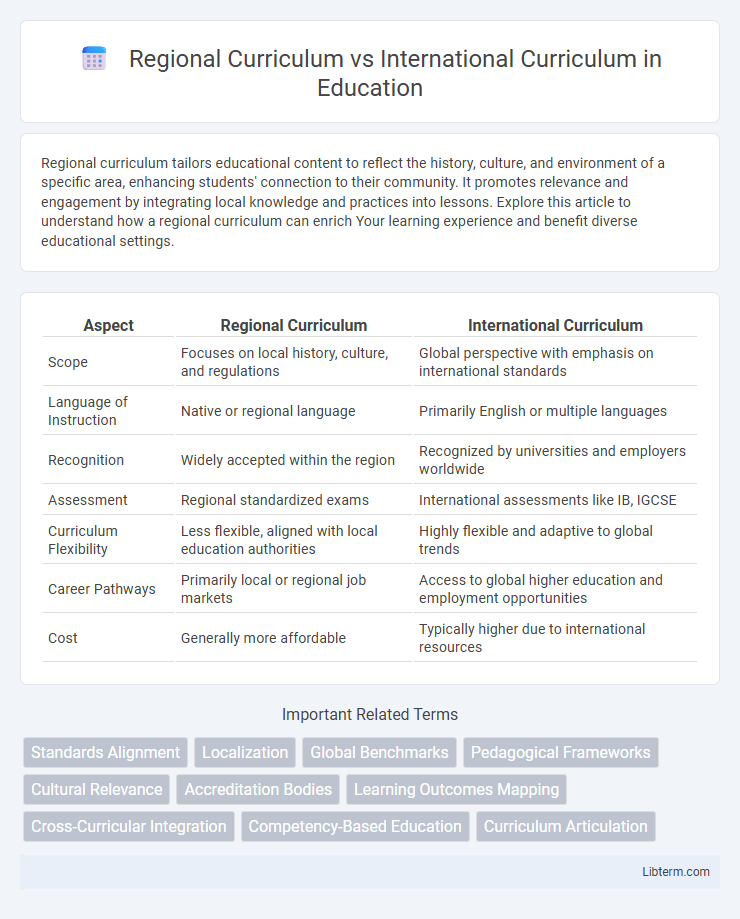Regional curriculum tailors educational content to reflect the history, culture, and environment of a specific area, enhancing students' connection to their community. It promotes relevance and engagement by integrating local knowledge and practices into lessons. Explore this article to understand how a regional curriculum can enrich Your learning experience and benefit diverse educational settings.
Table of Comparison
| Aspect | Regional Curriculum | International Curriculum |
|---|---|---|
| Scope | Focuses on local history, culture, and regulations | Global perspective with emphasis on international standards |
| Language of Instruction | Native or regional language | Primarily English or multiple languages |
| Recognition | Widely accepted within the region | Recognized by universities and employers worldwide |
| Assessment | Regional standardized exams | International assessments like IB, IGCSE |
| Curriculum Flexibility | Less flexible, aligned with local education authorities | Highly flexible and adaptive to global trends |
| Career Pathways | Primarily local or regional job markets | Access to global higher education and employment opportunities |
| Cost | Generally more affordable | Typically higher due to international resources |
Overview of Regional and International Curricula
Regional curricula align closely with local cultural, historical, and linguistic contexts, emphasizing national standards and community values to foster regional identity and relevance. International curricula, such as the International Baccalaureate (IB) or Cambridge, provide a standardized framework designed for global applicability, promoting critical thinking and cross-cultural competencies. Both cater to different educational goals: regional curricula support localized learning objectives, while international curricula prepare students for global mobility and diverse higher education opportunities.
Key Differences Between Regional and International Approaches
Regional curriculum emphasizes local culture, language, and national standards to align education with community values and government regulations. International curriculum, such as the IB or Cambridge programs, offers a globally recognized framework promoting critical thinking, intercultural understanding, and standardized assessments across countries. Regional approaches prioritize contextual relevance, while international curricula focus on global competencies and mobility for students.
Curriculum Objectives and Educational Philosophy
Regional curricula emphasize cultural relevance and local values, aiming to foster students' understanding of their community and heritage through context-specific knowledge and skills. International curricula prioritize global competencies, critical thinking, and adaptability, preparing students for diverse, cross-cultural environments with a focus on universal academic standards. The educational philosophy in regional curricula centers on preserving identity and addressing local needs, while international curricula promote inclusivity, intercultural awareness, and lifelong learning.
Subject Content and Course Structure Comparison
Regional curriculum emphasizes locally relevant subject content aligned with national standards, focusing on regional history, language, and culture, while international curriculum offers a globally standardized syllabus with diverse cultural perspectives. Course structure in regional curricula tends to follow a fixed, uniform progression emphasizing depth in specific subjects, whereas international curricula adopt flexible, interdisciplinary modules encouraging critical thinking and adaptability. Assessment methods in regional curricula are often exam-centric and content-specific, contrasting with the international approach of continuous evaluation and skills-based assessments.
Assessment Methods and Evaluation Standards
Assessment methods in regional curricula typically emphasize standardized tests aligned with local education policies and cultural contexts, ensuring relevance to national standards. International curricula adopt diverse evaluation standards, including formative assessments, portfolios, and criterion-referenced grading, promoting global benchmarks and comparability across countries. Differences in assessment frequency, grading scales, and performance criteria reflect the varied objectives of regional versus international educational frameworks.
Cultural Relevance and Global Perspective
Regional curricula emphasize cultural relevance by integrating local history, language, and traditions to foster a strong sense of identity among students, enhancing community connection. International curricula prioritize a global perspective, offering diverse content and standardized frameworks that prepare students for cross-cultural communication and global citizenship. Balancing both approaches supports students in gaining a grounded cultural understanding while developing skills necessary for international environments.
Teacher Qualifications and Professional Development
Teacher qualifications for regional curricula often emphasize familiarity with local educational standards, cultural contexts, and language proficiency to effectively address community-specific learning goals. International curricula require educators to possess expertise in global teaching methodologies, multilingual capabilities, and adaptability to diverse student backgrounds, ensuring alignment with international benchmarks. Professional development programs for regional curriculum teachers prioritize continuous training in national policies and culturally responsive pedagogy, whereas international curriculum educators engage in workshops focused on cross-cultural competence and global educational innovations.
Student Adaptability and Mobility
Regional curriculum often emphasizes local culture, language, and educational standards, which may limit student adaptability when transferring to different regions. International curriculum, such as the IB or Cambridge programs, promotes global perspectives and standardized content, enhancing student mobility for higher education and career opportunities worldwide. Students exposed to international curricula typically develop stronger cross-cultural communication skills and adaptability in diverse academic environments.
Impact on University Admissions and Career Prospects
Regional curricula often align closely with local higher education requirements, facilitating smoother university admissions within the home country but potentially limiting recognition abroad. International curricula like the IB or Cambridge A-Levels provide universally accepted qualifications, enhancing global university admission opportunities and competitive advantage in multinational career markets. Employers and institutions frequently value international curricula for their emphasis on critical thinking and adaptability, which align with global professional standards.
Choosing the Right Curriculum: Factors for Parents and Schools
Choosing the right curriculum involves evaluating factors such as cultural relevance, language of instruction, and future academic pathways, which differ significantly between regional and international curricula. Regional curricula often emphasize local history and values, supporting students' integration into their community, while international curricula provide standardized content promoting global competencies and university recognition worldwide. Parents and schools must consider the student's long-term goals, learning style, and the curriculum's alignment with higher education institutions to make an informed decision.
Regional Curriculum Infographic

 libterm.com
libterm.com